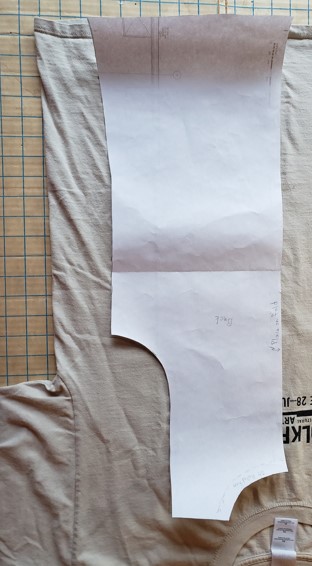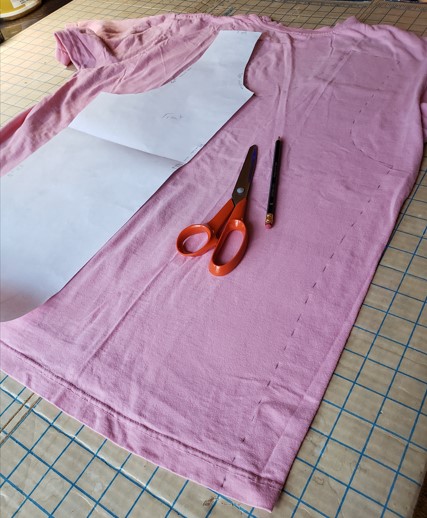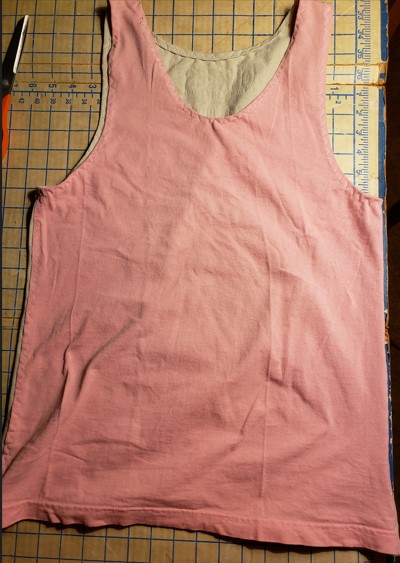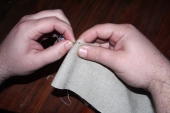
 19
19




Zone 6, 45 inches precipitation, hard clay soil




 8
8




 12
12




Gardens in my mind never need water
Castles in the air never have a wet basement
Well made buildings are fractal -- equally intelligent design at every level of detail.
Bright sparks remind others that they too can dance
What I am looking for is looking for me too!

 7
7




Zone 6, 45 inches precipitation, hard clay soil




 8
8




Gardens in my mind never need water
Castles in the air never have a wet basement
Well made buildings are fractal -- equally intelligent design at every level of detail.
Bright sparks remind others that they too can dance
What I am looking for is looking for me too!

 3
3




Arthur Angaran wrote:Hi, I get oversized clothing for whatever I need, and then take them in. This way it allows for a more tailored look.
I can buy good quality clothes at the reuse store. After enough practice of learning patterns, and taking clothes in there are some opportunities for a home business if I have time. Usually I just make a good set for homeless people who are looking for a job, and I don't expect money for my service.




 11
11




Zone 6, 45 inches precipitation, hard clay soil




 12
12




 14
14




"Also, just as you want men to do to you, do the same way to them" (Luke 6:31)
 5
5




Medicinal herbs, kitchen herbs, perennial edibles and berries: https://mountainherbs.net/ grown in the Blue Mountains, Australia
 16
16





 10
10




 2
2




Mediterranean climate, hugel trenches, fabulous clay soil high in nutrients, self-watering containers with hugel layers, keyhole composting with low hugel raised beds, thick Back to Eden Wood chips mulch (distinguished from Bark chips), using as many native plants as possible....all drought tolerant.
 4
4




I grew up machine sewing and was never taught to hand-sew efficiently. Lately, I've been watching some of the period clothing videos, and that got me looking at how to hand stitch. I can hand stitch for a 1/2 hour in an evening and feel like a project made progress, and I'm a convert. Particularly if I'm renovating or repairing something, hand stitching may be just as fast as trying to machine sew through a narrow gap. The fact that I don't actually need much clothes helps - it's not like I'm going places daily where I need to be "fashionable" - my ducks don't care!Angelika Maier wrote:I like watching interviews and shows. All what I am doing is hand sewing with fabrics from the op shop.
Visit Redhawk's soil series: https://permies.com/wiki/redhawk-soil
How permies.com works: https://permies.com/wiki/34193/permies-works-links-threads
 7
7




I admit I avoid iron-on like the plague. I've met the odd person who seems to like them - maybe they found a brand that genuinely works or have an iron that truly fuses them, but I'll stick to mending with needle and thread.Cristo Balete wrote:Kena, would it be possible to post a picture of how you repair jeans? I can't believe how fast pants wear out these days, and the iron-on patches don't work worth beans....thanks.
Visit Redhawk's soil series: https://permies.com/wiki/redhawk-soil
How permies.com works: https://permies.com/wiki/34193/permies-works-links-threads
 2
2




Cristo Balete wrote:Kena, would it be possible to post a picture of how you repair jeans? I can't believe how fast pants wear out these days, and the iron-on patches don't work worth beans....thanks.
 2
2




Jay Angler wrote:[qI admit I avoid iron-on like the plague. I've met the odd person who seems to like them - maybe they found a brand that genuinely works or have an iron that truly fuses them, but I'll stick to mending with needle and thread.
 8
8




 6
6




 5
5




 10
10




Zone 6, 45 inches precipitation, hard clay soil




 7
7




"How fleeting are all human passions compared with the massive continuity of ducks.“ — Dorothy L. Sayers












 4
4




 3
3




Mercy Pergande wrote:This abundance may be region-specific to me, but I see a lot of sewing machines and notions listed for free on Craigslist or other "freecycle" forums, or inexpensively in estate sales ( Estatesales.net lists them by area and date and often includes pictures of the offered items so you can target sales with those kinds of things) Estate sales are also a great resource for old linens and textiles that can be used for sewing and the textiles are often higher quality than what is commonly available now, linen, high thread count cotton damasks, lace and embroidery. I have seen boxes of notions, zippers, bias binding, trims, and buttons for a few dollars.
Zone 6, 45 inches precipitation, hard clay soil




 4
4




Shawn Foster wrote:Speaking of inexpensive/free machines... If you live along the I-5 corridor in the Medford-ish Oregon area (or can get here) and want a sewing machine and don't have one, I can provide! I have two or three straight-stitch vintage machines that don't need to live here any more. These do reverse, but they don't zigzag or any other fanciness. They are solid, reliable, easy to use and easy to repair machines, though, and at least one can be converted to hand-crank if you so desire. Send me a purple moosage if you're interested. If you have something to trade, that would be awesome, but mostly I want the floor space these are taking up.
Obviously, there's an expiration date on this offer. Once they're gone, they're gone. I'll post here with an update when they are.




 8
8




Zone 6, 45 inches precipitation, hard clay soil




 5
5




Pearl Sutton wrote:
I buy Christmas paper after the holiday for making patterns. I look for designs that have a square grid to them, that lets me use it as giant graph paper. A design like that also lets you cut out pieces on the grain or with the nap by laying them out as you make them so the grid of the paper is how you want the grain. And the nap is right if the snowman is right side up (or whatever lets you orient it.) Some wrapping paper has a grid marked on the back, so when you are wrapping you can make straight cuts. That's the kind I like best, it's basically long pieces of graph paper! I'll take that type in any design, as it doesn't need gridded artwork to be useful. I hit a bunch of it a while back, bought several of the biggest rolls I could find.
:D
Gardens in my mind never need water
Castles in the air never have a wet basement
Well made buildings are fractal -- equally intelligent design at every level of detail.
Bright sparks remind others that they too can dance
What I am looking for is looking for me too!

 5
5




Pearl Sutton wrote:
Bumping this thought, it's the time of year that wrapping paper is around. Designs with a square grid or paper with a cutting grid on back are WELL worth looking for while you are out this time of year! After Christmas sales are the cheapest, but options are much fewer.
Zone 6, 45 inches precipitation, hard clay soil




 6
6







Visit Redhawk's soil series: https://permies.com/wiki/redhawk-soil
How permies.com works: https://permies.com/wiki/34193/permies-works-links-threads
 4
4




Visit Redhawk's soil series: https://permies.com/wiki/redhawk-soil
How permies.com works: https://permies.com/wiki/34193/permies-works-links-threads
 2
2




Radis.
Living and growing on my small homestead near a project of permaculture school.
"There are no non-radical options left before us" Naomie Klein in This Changes Everything
 4
4




Raphaël Blais wrote:I wanted this winter to buy a used sewing machine, but i don't know nothing in this subjet. How can i know i buy a sturdy one, or if it can be repair on the long term ? Will it last more than one generation ?
Zone 6, 45 inches precipitation, hard clay soil















 3
3




May Lotito wrote:
I typically see electric metal sewing machine from 70s to 90s selling for $10 in yard sell or auction. They are built sturdy and easy to maintain.
Radis.
Living and growing on my small homestead near a project of permaculture school.
"There are no non-radical options left before us" Naomie Klein in This Changes Everything
 3
3




"The only thing...more expensive than education is ignorance."~Ben Franklin. "We can easily forgive a child who is afraid of the dark; the real tragedy of life is when men are afraid of the light." ~ Plato
 9
9




I am only one, but still I am one. I cannot do everything, but still I can do something; and because I cannot do everything, I will not refuse to do something that I can do. (E.E.Hale)
 5
5




Well, now that you've got it filling up your fabric stash, think outside the box for something/someone the fabric *would* be good for.Anita Martin wrote:* Don't get attracted by beautiful cotton prints on sale. In real life I don't wear much flowery or graphic patterns but prefer subtle colours. Just because they look nice does not mean that you will make something wearable out of them.
The only way I can think of upcycling that one is to donate it to a sewing class or Charity shop.* Similarly, don't get attracted by a pattern because you like the model/style but wouldn't wear that yourself (because you don't have the occasion, look, body, overall style)
* Find a pattern company that caters to your size. For me, Vogue, Burda etc. are terrible, they do not fit at all and I have miles of fabric that I have to remove later and still don't have a good fit. I stick to small independent pattern makers where the XS or sometimes S is perfect for me (German patternmakers Pattydoo, freuleins, Lillesol, international Itch to Stitch, Sew Liberated, The Assembly Line and sometimes freebooks).
Absolutely! And what I said above. #2 son had a hoodie that I'd made him that he adored. I didn't have enough fabric to make him another one, but I had two complementary fabrics. "Joining" fabric was a thing that everyone did back when fabric was cherished. So I used the pattern as a guide to decide how to join the two colours simply to make another great hoodie. I am so hard to fit, I have a pants pattern I've used at least 5 times over more than a decade.* If you have found a pattern that fits, make several garments because once you get the hang of it and jotted down all necessary changes it will be quicker and more satisfying. And if you use different fabrics nobody will notice.
There are some blouses I have made more than once and a jeans pattern which I haven sewn in corduroy twice.
Visit Redhawk's soil series: https://permies.com/wiki/redhawk-soil
How permies.com works: https://permies.com/wiki/34193/permies-works-links-threads






 7
7




Anita Martin wrote:...
* Similarly, don't get attracted by a pattern because you like the model/style but wouldn't wear that yourself (because you don't have the occasion, look, body, overall style)
* Find a pattern company that caters to your size. For me, Vogue, Burda etc. are terrible, they do not fit at all and I have miles of fabric that I have to remove later and still don't have a good fit. I stick to small independent pattern makers where the XS or sometimes S is perfect for me (German patternmakers Pattydoo, freuleins, Lillesol, international Itch to Stitch, Sew Liberated, The Assembly Line and sometimes freebooks).
* If you have found a pattern that fits, make several garments because once you get the hang of it and jotted down all necessary changes it will be quicker and more satisfying. And if you use different fabrics nobody will notice.
...
"Also, just as you want men to do to you, do the same way to them" (Luke 6:31)
 6
6




I am only one, but still I am one. I cannot do everything, but still I can do something; and because I cannot do everything, I will not refuse to do something that I can do. (E.E.Hale)

|
Alas, poor Yorick, he knew this tiny ad:
Rocket Mass Heater Resources Wiki
https://permies.com/w/rmh-resources
|









